Pioneer Pacific College Demographics & Diversity Report
Is Pioneer Pacific College really diverse? College Factual's 2021 diversity report reveals the truth and stats about diversity at Pioneer Pacific College. We analyzed racial demographics, gender ratios, student age ranges, and more.- Student Population
- Diversity Rankings
- Racial/Ethnic Diversity
- Male/Female Diversity
- Location Diversity
- Student Age Diversity
Featured schools near , edit
Pioneer Pacific College Student Population
How Many Students Attend Pioneer Pacific College?
Pioneer Pacific College total enrollment is approximately 740 students.
Pioneer Pacific College Undergraduate Population
Male/Female Breakdown of Undergraduates
The full-time Pioneer Pacific College undergraduate population is made up of 72% women, and 28% men.
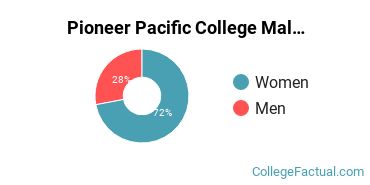
For the gender breakdown for all students, go here.
Pioneer Pacific College Racial/Ethnic Breakdown of Undergraduates
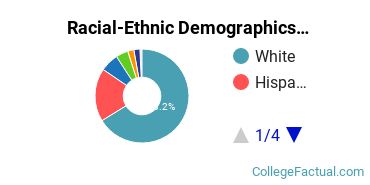
| Race/Ethnicity | Number |
|---|---|
| White | 282 |
| Hispanic | 78 |
| Multi-Ethnic | 27 |
| Unknown | 18 |
| Asian | 9 |
| Black or African American | 9 |
| International | 3 |
| Native Hawaiian or Pacific Islander | 0 |
See racial/ethnic breakdown for all students.
Below Average Ranking in Overall Diversity Nationwide
Pioneer Pacific College achieved a College Factual diversity rank of #2,410 out of 3,514 total schools in the ranking.
To get this overall diversity score, we looked at the combined rankings of student racial/ethnic diversity, as well as age, gender, and geographic diversity.
How Does Pioneer Pacific College Diversity Compare to National Averages?
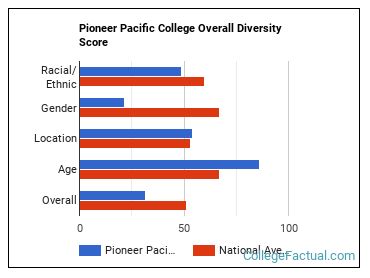
Pioneer Pacific College is considered below average in terms of overall diversity on a national level. Some areas of diversity in the school may be better than others.
Average Racial/Ethnic Diversity
Pioneer Pacific College is ranked 1,942 out of 3,790 when it comes to the racial/ethnic diversity of the students.
Pioneer Pacific College racial/ethnic diversity is similar to national averages.
Pioneer Pacific College Racial Demographics:
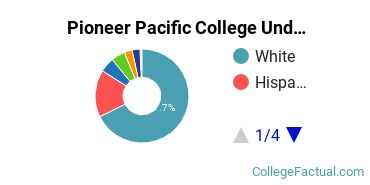
| Race/Ethnicity | Number |
|---|---|
| White | 495 |
| Hispanic | 119 |
| Unknown | 37 |
| Multi-Ethnic | 35 |
| Asian | 20 |
| Black or African American | 20 |
| International | 4 |
| Native Hawaiian or Pacific Islander | 1 |
Low Racial/Ethnic Diversity Among Faculty
Pioneer Pacific College Faculty Racial/Ethnic Demographics:
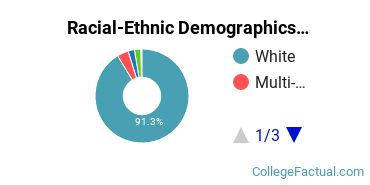
| Ethnicity | Number of Faculty |
|---|---|
| White | 210 |
| Multi-Ethnic | 9 |
| Black or African American | 5 |
| Asian | 5 |
| Native Hawaiian or Pacific Islander | 1 |
| Hispanic | 0 |
| International | 0 |
| Unknown | 0 |
Learn more about the faculty at Pioneer Pacific College.
Average Male/Female Ratio
Pioneer Pacific College ranks 2,979 out of 3,790 when it comes to gender parity on campus.
This school is more popular with women than with men.
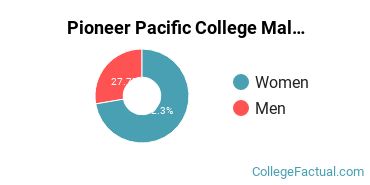
There are approximately 535 female students and 205 male students at Pioneer Pacific College.
Slightly Unbalanced Ratio of Male & Female Teachers
Reporting of the gender of Pioneer Pacific College is unknown or unavailable.
There are more female teachers than male teachers at this school.
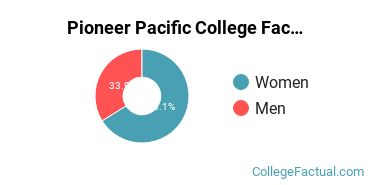
More about Pioneer Pacific College faculty.
There are approximately 156 female teachers and 80 male teachers.
Average Geographic Diversity
Pioneer Pacific College ranks 1,575 out of 2,183 when it comes to geographic diversity.
15.12% of Pioneer Pacific College students come from out of state, and 0% come from out of the country.
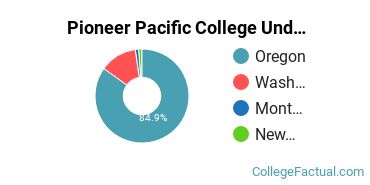
The undergraduate student body is split among 4 states (may include Washington D.C.). Click on the map for more detail.
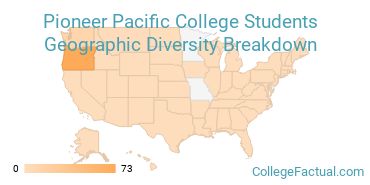
Top 5 States
| State | Amount |
|---|---|
| Oregon | 73 |
| Washington | 11 |
| Montana | 1 |
| New Jersey | 1 |
| Alaska | 0 |
International Students at Pioneer Pacific College
Students from 3 countries are represented at this school, with the majority of the international students coming from India, Japan, and Italy.
Learn more about international students at Pioneer Pacific College.
High Student Age Diversity
A traditional college student is defined as being between the ages of 18-21. At Pioneer Pacific College, 25.19% of students fall into that category, compared to the national average of 60%.
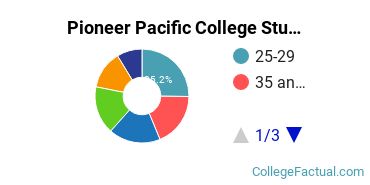
| Student Age Group | Amount |
|---|---|
| 25-29 | 260 |
| 35 and over | 192 |
| 22-24 | 184 |
| 20-21 | 171 |
| 30-34 | 136 |
| 18-19 | 90 |
| Under 18 | 0 |
Notes and References
Footnotes
*The racial-ethnic minorities count is calculated by taking the total number of students and subtracting white students, international students, and students whose race/ethnicity was unknown. This number is then divided by the total number of students at the school to obtain the racial-ethnic minorities percentage.
References

